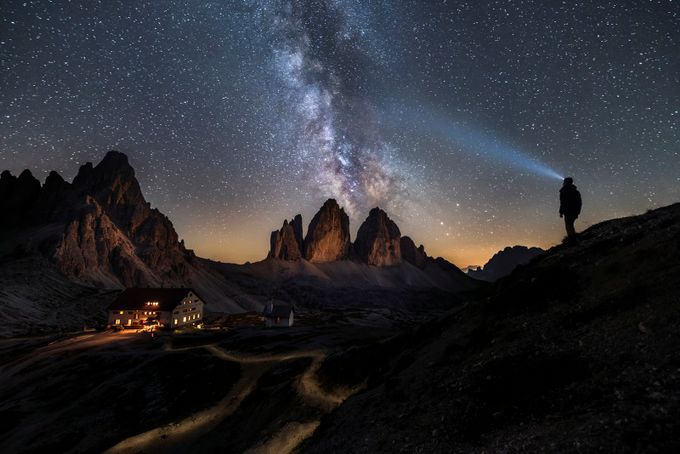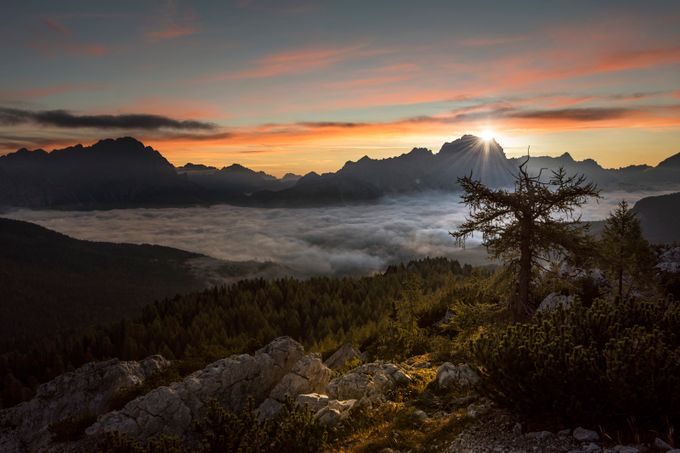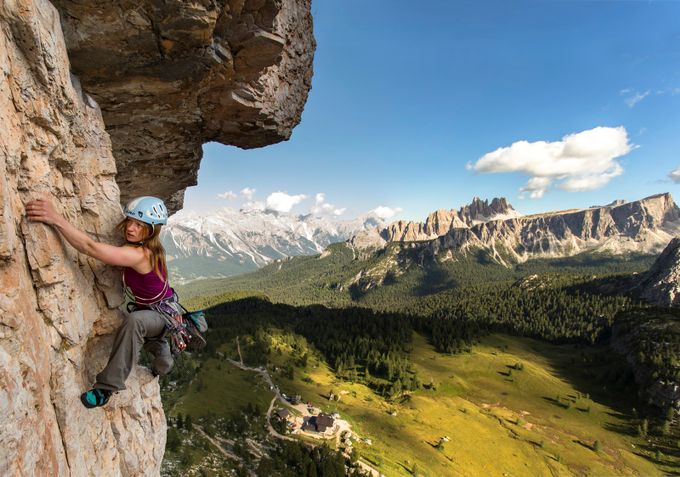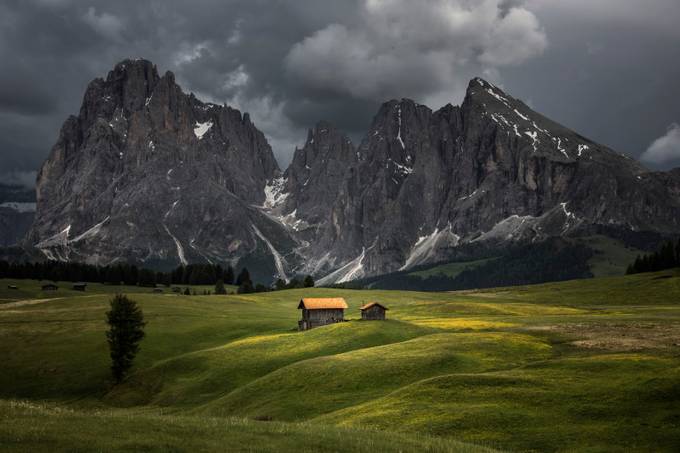Author, ViewBug member and professional photographer James Rushforth describes 52 locations to visit and photograph in this 352 page photo location and visitor guidebook, illustrated with over 400 beautiful photographs.
Introduction
Located in northern Italy, the majestic spires of the Dolomites are widely regarded as the most photogenic mountain range on the planet and indeed it’s rare to see an international landscape photography competition without at least one finalist image featuring these stunning natural formations. Once known as the Monti Pallidi or ‘Pale Alps’, the carbonate rock takes its current name from the 18th century French mineralogist Déodat Gratet de Dolomieu and is characterised by impossibly steep towers, spires, pinnacles, jagged ridges and sharp pinnacles that thrust skyward from the picturesque villages and alpine meadows below. These resplendent peaks are often likened to majestic natural cathedrals and invoke an almost religious sense of wonder among the South Tyrolean populace and visitors alike.
Spanning an area of some 500 square miles, this complex labyrinth of rock walls, forest, rivers, alpine pastures and wild flower meadows is surprisingly accessible. The excellent road, transport and lift networks found within the Dolomites ensure that many of the best photo locations are blessed with short approaches that can be enjoyed by photographers with limited mobility. For the intrepid adventurer, possibilities abound and there are many hidden gems located off the beaten track which can be enjoyed in solitude. The area was designated a UNESCO World Heritage Site in 2009 and is exceptionally diverse from a photographer’s perspective, both in terms of appearance and culture. The unique mélange of Italian, Austrian and Ladin societies has created a trilingual community which is exceptionally distinct in nature and rich in heritage, and the resulting Tyrolean architecture, traditional dress and farming methods provide the perfect foreground to the varied and ever-changing backdrops.
How to get there
The Dolomites are located equidistant between Venice (and Treviso), Innsbruck and Verona, all of which can be reached from the UK by budget airlines. Other options are Munich, Brescia and Bergamo. It is possible to continue to the Dolomites by public transport and private shuttle services, but given the difficulties in accessing many of the locations in this guide by bus, it is recommended to hire a car at the airport and complete the journey by road. Rough distances and driving times to Cortina d’Ampezzo from the major airports are given below:
Major airport distance & drive times
Treviso: 130 km, 2h 10 min
Venice Marco Polo: 149 km, 2h 10 min
Innsbruck: 163 km, 2h 25 min
Verona Villafranca Airport: 270 km, 3h 00 min
Brescia: 322 km: 3h 40 min
Munich: 357 km: 3h 50 min
Bergamo: 370 km: 4h 00 min
Where to stay
There is no shortage of accommodation in the Dolomites, and all the main towns and villages offer a variety of options ranging from basic to the most luxurious. Hotels of all standards abound and there are numerous garnì (bed and breakfasts) and self-catering apartments. Hotels styling themselves as ‘Sport’ or offering ‘Wellness’ usually have spa facilities such as saunas, steam rooms and Turkish baths.
In addition to the accommodation in the valleys, there are countless rifugios in the mountains themselves; literally meaning refuge, these are more akin to plush alpine hotels offering good sleeping quarters (sometimes with a choice between private rooms or dorms), a decent breakfast and a three-course evening meal.
Accommodation in most places in the Dolomites is available with three options – solo pernottamento (overnight stay), con colazione (bed and breakfast) and mezza pensione (half-board). If opting for the bunk room option in the rifugios, a sleeping bag liner is usually expected. There are also quite a few campsites dotted around the Dolomites; many of these have developed into quite luxurious sites with good facilities, but unfortunately this does mean that they are not the budget option they once were.
If you visit the Dolomites in a camper van, the cheapest option is to make use of the ‘aree attrezzate’ or ‘stellplatz’ – these are effectively car parks where camper vans are allowed to park for a small fee. There is often running water and sometimes a waste water disposal area. Finally if you really are on a shoestring, there is ample parking at the top of most of the passes and although overnight stays are not officially permitted, you may find safety in numbers with many other camper vans, particularly in high season.
In some of the more remote mountainous areas, there are a number of ‘bivacchi’ or shelters. These are rarely more than just that, with facilities limited to bunks and blankets, but can be a novel way of spending a night when attempting some of the longer or more isolated routes. Use is on an honesty basis and it is not possible to guarantee a space, although despite this they are rarely crowded.
Nearly every town or village in the Dolomites has a tourist information office (Ufficio Turistico) which provides good, up-to-date information on accommodation, as well as information on lifts, public transport and cultural events. English is usually spoken in the larger offices, while the offices in the smaller villages may require a little more gesticulating.
Five recommended locations:
Tre Cime di Lavaredo
The Tre Cime di Lavaredo are without doubt the most famous landmark in the Dolomites and visitors come from all over the world to view the celebrated triad. For the uninitiated there are in fact eleven or so towers that make up the group, but it is the three largest monoliths and their north faces that have captured the imagination of travellers, climbers and photographers alike for centuries. Cima Piccola, as the name suggests, is the smallest of the three and is found on the east side. Cima Grande is the largest at 2999m and is particularly renowned as one of the six great alpine north faces, making it much coveted in the climbing fraternity. Cima Ovest on the west side of the group completes the iconic trinity and is superbly situated on a pedestal above three small and picturesque lakes.
While the three towers are the undisputed stars of the show, the surrounding area also provides some of the best views in the Dolomites.
Unfortunately, during peak season the area does get a little overrun with visitors coming to see the towers and this coupled with the rather expensive toll road can cause the area to feel very commercial. However, during a photographer’s ‘golden hours’ the area is wonderfully quiet, making it a perfect early morning and evening venue when the crowds have dispersed for the day and you can take in the magical scene in relative solitude. An overnight stay at Rifugio Locatelli is particularly recommended as it provides one of the best views of the north faces.
Cinque Torri
Cutting a dramatic profile above the Cortina basin overlooking the Passo Falzarego, the famous five towers of Cinque Torri are one of the most strikingly beautiful and instantly recognizable rock formations in the Dolomites. Scattered between the main spires lies a wonderful labyrinth of scree, boulders, tunnels and trenches dating back to the Great War. Such was the strategic significance of the area that today the site plays host to a superb open air museum with carefully preserved soldiers’ quarters, artillery positions and lookout posts.
Exceptionally photogenic in their own right, the towers are nearly always covered in rock climbers scaling the steep faces, adding some superb drama to the already impressive scene.
Two weekends a year in midsummer, visitors can enjoy the ‘Touching History’ event where enthusiasts from all over the world dress in military uniform of the era and take part in a remembrance ceremony commemorating the First World War.
The towers are easily accessed via the Rifugio Bai de Dones chairlift. This makes them a deservedly popular tourist destination throughout the summer months, and one which can confidently be recommended as a must-see location for any photography enthusiast.
Alpe di Siusi
Spanning an area of 6000 hectares (or 56 square kilometres), the Alpe di Siusi is Europe’s largest high-altitude alpine meadow. The vast plateau harbours some 800 different species of wild flower and is liberally studded with rustic wooden huts, babbling streams and small ponds. Set against the superbly proportioned Sassolungo group, an epitome of the Dolomitic ideal of what a mountain should look like, there is a nearly infinite number of creative photo opportunities to be had here. To take full advantage of the scale of this landscape, a stay in one of the many hotels and rifugios atop the plateau itself is highly recommended.
Città dei Sassi
The sprawling boulderfield of Città dei Sassi (City of Rocks) extends just below the Passo Sella, in the shadow of the famous Sassolungo group. While it is an accepted fact that this vast labyrinth of boulders was created by a huge rockfall from Sassolungo, there is much academic debate as to how and when the event occurred. Some believe the event was triggered by seismic activity; others attribute it to lack of support following the retreat of the glaciers. Either way, the collapse of the rock faces undoubtedly occurred after the last major glacial expansion, around 20,000 years ago, as otherwise the boulders would have been carried down to the valleys and there would be no trace of them below their original position.
Cascate Di Fanis & Cengia di Mattia
At the confluence of the Fanes, Travenenzes and Ra Vales valleys lie the remote Cascate di Fanis waterfalls, part of a hugely significant hydro-geological landscape that has helped shape the Parco delle Dolomiti d’Ampezzo. This unspoilt assortment of narrow gorges, rocky ravines and plunging rapids provides a spectacular yet seldom frequented photo opportunity with the chance to shoot behind two impressive cascades.
Although never too steep, the approach is long and the best compositions are accessed by short sections of Grade 1 via ferrata with some scrambling above exposed terrain. As such the location can only be recommended to those with extensive mountain experience and a head for heights.
Visit jamesrushforth's profile to see more inspiring shots.



















